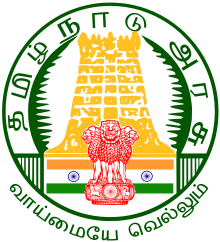Pandya
The Pandya were a south Indian dynasty. They belong to the Tamils , sat in Madurai and their peak of power was in the 13th century under Jatavarman Sundara (r. 1251–1268).
The Pandya in antiquity
A dynasty of this name already existed in Ashoka's time, alongside the Cholas and Cheras (or Keralas). Like its neighbors, it benefited from the regular trade that ran across the southern tip of India to the Roman Empire. So came z. B. a Pandya embassy around the year 13 to Emperor Augustus in Rome. The early Pandya kings kept Roman soldiers as bodyguards, described in Tamil literature as "dumb strangers with long cloaks, weapons and cruel souls". They traded in luxury goods: shells, diamonds and precious stones, gold articles, spices, perfumes and especially pearls. The importance of pearls is mentioned in both Megasthenes (4th century BC) and Marco Polo (13th century). The population lived from fishing, salt extraction and trade. The Pandya kings appeared as promoters of poetry, from the 1st to the 4th century numerous works were written: the Sangam literature . The rule of the kings was still largely based on family and tribal ties and the predominant power of the region lay with the Cheras.
Partial list of the Pandyas of the Sangam period:
- Nedunj Cheliyan I. (Aariyap Padai Kadantha Nedunj Cheliyan)
- Pudappandiyan
- Mudukudumi Paruvaludhi
- Nedunj Cheliyan II.
- Nan Maran
- Nedunj Cheliyan III. (Talaiyaalanganathu Seruvendra Nedunj Cheliyan)
- Maran Valudi
- Musiri Mutriya Cheliyan
- Ukkirap Peruvaludi
Pandya of the early Middle Ages
The intervention of the Kalabhra ended the Sangam period in the southern Indian kingdoms and the Middle Ages began. The Pallava rose to dominance in the south at the end of the 6th century and pushed the Pandya and Chola down to vassals. Little that is known about the Pandya kings of the 7th to 10th centuries relates almost exclusively to constant wars with the Pallavas, Cheras and Ceylon . The Buddhist Chinese monk Xuanzang visited the kingdom in 640 AD. The influence of the Buddhists was already waning at the time and shortly afterwards the king converted to Shiva worship and had the Jainas murdered.
Pandya kings in the 6th – 10th centuries century
- 560-590 Kadungon
- 590-620 Maravarman Avani Culamani
- 620-640 Cezhiyan Cendan
- 670-710 Arikesari Maravarman Nindraseer Nedumaaran
- 710-735 Kochadaiyan Ranadhiran
- 735-765 Arikesari Parankusa Maravarman Rajasimha I.
- 765-790 Parantaka Nedunjadaiyan
- 790-800 Rasasingan II.
- 800-830 Varagunan I.
- 830-862 Sirmara Srivallabha
- 862-880 Varagunavarman II.
- 880-900 Parantaka Viranarayana
- 900–920 Maravarman Rajasimha II.
Vassals and rivals of the Cholas
In the early 11th century, the Pandya became vassals of Chola Rajaraja I (ruled 985-1014). Only at the end of the 12th century. They began with the help of the King of Ceylon , Parakramabahu released again by the Chola. Soon the Chola king Rajaraja III. (r. 1216–1252) lost his throne to the Pandya Maravarman (r. 1216–1238), if Hoysala Narasimha II. (r. 1220–1234) had not saved him again. The most successful king of the dynasty was Jatavarman Sundara (ruled 1251–1268). He defeated the Hoysala king Someshvara II (ruled 1234-1263), who fell in a battle and intervened in Ceylon - in short: he held supremacy in southern India. Finally, the Chola Empire ended in 1279. The Pandya could not enjoy this dominance for a long time: The campaign of Malik Kafur, the general of the Delhi Sultan Ala ud-Din Khalji to southern India shook the Pandya position of power in 1311 (favored by a conflict of succession to the throne). The capital Madurai was burned down in spite of stiff resistance and the temple cities plundered.
The Pandya were replaced by the Sultanate of Madurai (1334-1370).
Pandya kings in the 10th-14th centuries century

- Sundara Pandya I
- Vira Pandya I.
- Vira Pandya II
- Amarabhujanga Tivrakopa
- Jatavarman Sundara Chola Pandya
- Maravarman Vikrama Chola Pandya
- Maravarman Parakrama Chola Pandya
- Jatavarman Chola Pandya
- 1101-1124 Srivallabha Manakulachala
- 1132–1161 Maaravaramban Seervallaban
- 1161-1162 Parakrama Pandiyan
- Kulasekara Pandyan III
- Vira Pandyan III
- 1175-1180 Jatavarman Srivallaban
- 1180-1216 Jatavarman Kulasekara Devan
- 1216-1238 Maravarman Sundara Pandya
- 1238–1240 Sundaravaramban Kulasekaran II
- 1241–1251 Maaravaramban Sundara Pandiyan II
- 1251-1268 Jatavarman Sundara Pandyan
- 1268–1308 Maaravaramban Kulasekara Pandyan I
- 1309-1327 Sundara Pandyan IV
- 1309-1345 Vira Pandyan IV
literature
- Nilakanda Shasthri: The Pandyan Kingdom - Early Times to The Sixteenth Century. Swati, Chennai 1975
Web links
Individual evidence
- ↑ Kandadai Vaidyanatha Subrahmanya Aiyer; Kandadai Subrahmanya Vaidyanathan: Historical sketches of ancient Dekhan. Madras 1917, p. 82
- ↑ Husaini, AQ, pp. 8-17
- ↑ Sastri, KAN, pp. 22-25
- ↑ Purushottam, Vi.Pi, p. 42


